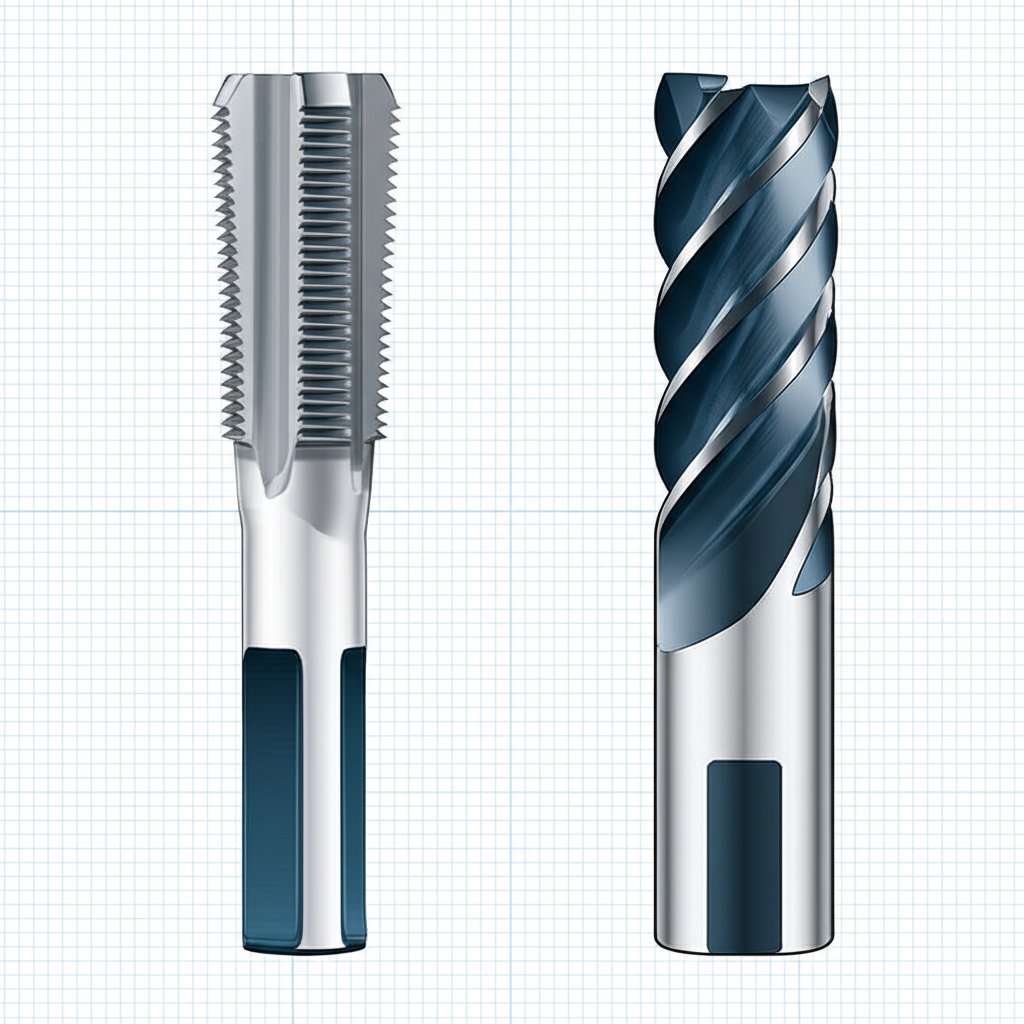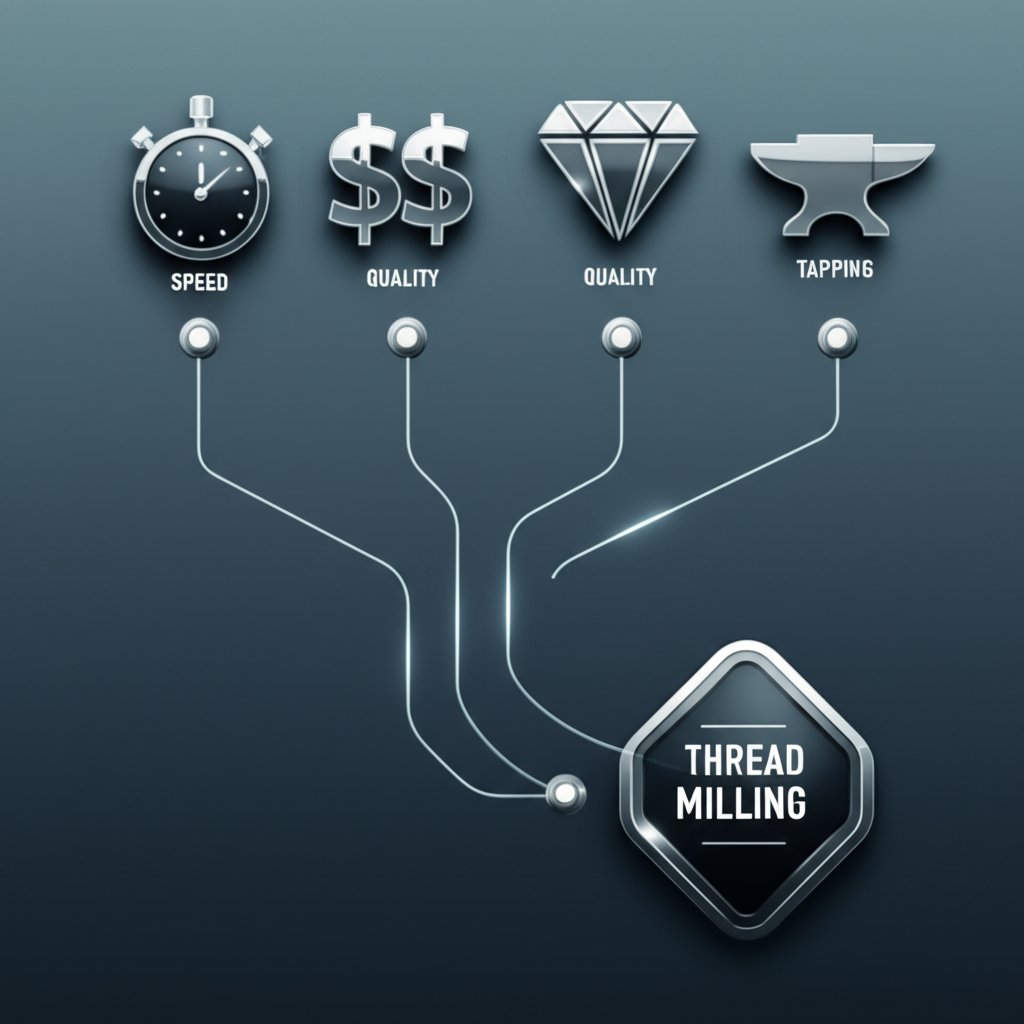Tapping vs Thread Milling CNC: A Machinist's Decision Guide

TL;DR
Choosing between tapping and thread milling in CNC machining involves a critical trade-off between speed and versatility. Tapping is a significantly faster and often more cost-effective method for producing high volumes of standard-sized internal threads. In contrast, thread milling is a slower process that offers superior thread quality, the flexibility to create various thread sizes with a single tool, and is a safer option for high-value or difficult-to-machine parts.
Fundamental Differences: The Machining Process Explained
Understanding the core mechanics of tapping and thread milling is essential to appreciating their distinct advantages and limitations. Though both processes create helical grooves, their methods of material removal and the machine movements involved are fundamentally different. Tapping is a more direct, forceful process, while thread milling is a more nuanced, controlled cutting operation that relies on complex CNC motion.
Tapping utilizes a tool, called a tap, that resembles a screw with cutting edges along its grooves. The process is straightforward: after a pilot hole is drilled, the tap is driven axially into the hole. The machine's spindle rotation and feed rate must be perfectly synchronized to match the thread's pitch. For example, to create a 1/4"-20 thread, the tap must advance precisely 0.05 inches for every full revolution. This rigid synchronization is why the process requires a machine with a 'rigid tapping' capability or specialized tapping heads.
Conversely, thread milling employs a rotating cutting tool that looks more like a small end mill with a thread form on its flutes. As detailed in guides from experts at Kennametal, this process is only possible on CNC machines capable of helical interpolation—simultaneous, coordinated movement in three axes (X, Y, and Z). The thread mill is first plunged into the center of the pre-drilled hole, moved radially to the hole wall, and then travels in a circular path while simultaneously moving up or down the Z-axis by one pitch distance. This controlled, multi-axis movement carves the thread into the workpiece, offering greater control over the final thread dimensions.
A key distinction highlighted by manufacturing service provider Xometry is that tapping is almost exclusively for creating internal threads. Thread milling, however, is far more versatile and can produce internal threads, external threads, and both right-hand and left-hand threads with the same tool. This inherent flexibility is a direct result of its sophisticated machining process.
| Feature | Tapping | Thread Milling |
|---|---|---|
| Tool Type | Tap (resembles a screw with cutting grooves) | Thread Mill (fluted cutter with thread profile) |
| Machine Motion | Synchronized 2-axis (rotation + axial feed) | 3-axis helical interpolation (X, Y, Z) |
| Thread Types | Primarily internal threads | Internal, external, right-hand, left-hand |
| Chip Formation | Long, continuous chips can cause issues | Small, manageable chips; better evacuation |

Head-to-Head Comparison: Speed vs. Quality & Precision
The central debate in tapping vs. thread milling revolves around the trade-off between production speed and the final quality of the thread. For many applications, the choice comes down to which of these factors is the higher priority. Tapping is the undisputed champion of speed, making it the go-to choice for high-volume manufacturing where cycle time is a critical cost driver.
Tapping creates a complete thread in a single, rapid pass. A standard 1/4"-20 thread might be tapped in just a few seconds. This efficiency is why it dominates industries like automotive manufacturing, where thousands of identical threaded holes are produced daily. However, this speed comes at the cost of precision and control. The forceful nature of tapping generates significant stress on both the tool and the workpiece, which can affect the thread's surface finish and dimensional accuracy. Furthermore, once a hole is tapped, there is no easy way to adjust the thread fit; the size is fixed by the tool itself.
Thread milling, while significantly slower, excels in producing threads of superior quality and precision. Because the tool cuts the thread form gradually with a lighter radial engagement, it produces an excellent surface finish and minimizes stress on the part. A key advantage noted by machine tool specialists at DATRON is the ability to precisely control the thread fit. By making minor adjustments to the tool path in the CNC program (cutter compensation), an operator can fine-tune the thread diameter to meet tight tolerances, which is impossible with a fixed-size tap. This level of control is crucial in high-precision industries like aerospace and medical device manufacturing.
Pros and Cons at a Glance
-
Tapping
- Pros: Exceptional speed, ideal for mass production. Simpler setup for standard jobs. Lower cost per tool for common sizes.
- Cons: Lower thread quality and surface finish. Fixed thread size with no room for adjustment. High risk of tool breakage, which can scrap an expensive part. Limited to internal threads.
-
Thread Milling
- Pros: Superior thread quality and surface finish. Full control over thread size and fit. One tool can produce multiple thread diameters of the same pitch. Safer process with lower risk of catastrophic tool failure. Can create internal and external threads.
- Cons: Significantly slower cycle times compared to tapping. Requires a more advanced CNC machine with 3-axis capability. Higher initial tool cost.
Tooling, Cost, and Machine Requirements Analysis
A thorough analysis of tapping versus thread milling must extend beyond the machining process to include the costs of tooling and the required equipment capabilities. The financial calculation is not as simple as comparing the price of a single tap to a single thread mill; it involves considering tool versatility, risk of part scrappage, and machine tool requirements.
From an initial cost perspective, tapping tools are generally less expensive. A standard tap for a common thread size is a relatively low-cost consumable. However, the downside is that a unique tap is required for every single thread size and pitch combination. A job shop working with diverse parts might need to stock a vast and costly inventory of taps. Furthermore, as noted by industrial supplier MSC Direct, a broken tap is a frequent and costly problem. When a tap breaks inside a hole, it is difficult to remove and often results in the entire workpiece—which may already have significant value—being scrapped.
Thread mills have a higher upfront cost, but this is offset by their incredible versatility. A single thread mill can be used to create any thread diameter that shares its pitch, both internal and external. This drastically reduces the number of tools required in inventory. While a thread mill can still break, it typically does so without becoming lodged in the part, meaning the expensive workpiece can often be salvaged. This reduction in risk is a major factor when machining high-value components or difficult materials like titanium and Inconel.
Machine requirements also differ significantly. Tapping can be performed on almost any CNC machine (and even manually), but it requires substantial spindle torque, especially for larger threads or tough materials. In contrast, thread milling requires less torque but is dependent on the machine's ability to perform precise helical interpolation. This capability is standard on modern CNC machining centers but may not be present on older or more basic equipment.
| Factor | Tapping | Thread Milling |
|---|---|---|
| Initial Tool Cost | Low per tool | High per tool |
| Tool Versatility | Low (one tool per thread size/pitch) | High (one tool for many diameters of the same pitch) |
| Risk of Part Scrap | High (due to tap breakage) | Low |
| Machine Capability | High torque required for large threads | Requires 3-axis helical interpolation |

Practical Application: When to Choose Tapping vs. Thread Milling
Making the right choice between tapping and thread milling is a practical decision based on the specific requirements of the job. There is no single 'better' method; the optimal process depends on balancing the competing priorities of speed, cost, quality, and flexibility. By evaluating the part material, production volume, thread specifications, and part value, a clear winner typically emerges for any given application.
Tapping is the clear choice for high-volume production of standard-sized internal threads, especially in easy-to-machine materials like aluminum or mild steel. If the primary goal is minimizing cycle time to reduce cost per part, and the thread quality requirements are not exceptionally stringent, tapping's speed advantage is unbeatable. As highlighted by Butler Bros., this is why tapping is prevalent in industries like automotive and general manufacturing where efficiency at scale is paramount.
Thread milling becomes the superior choice in a variety of more demanding scenarios. It is the preferred method for high-value components where a broken tap would be a catastrophic failure. When working with difficult-to-machine materials such as hardened steels, titanium, or superalloys, thread milling offers a more controlled and reliable process. It is also the only option for producing large-diameter threads that would require excessive torque to tap, or for creating custom, non-standard thread profiles. For shops that value flexibility and need to produce a wide range of thread sizes without investing in hundreds of different taps, thread milling provides a more economical long-term solution. For projects requiring such high-precision and versatile capabilities, partnering with an expert service can be beneficial. For instance, companies looking to accelerate their product development can explore options like XTJ's comprehensive formative manufacturing services, which offer rapid prototyping across numerous materials with expert engineering feedback.
Use this checklist to guide your decision:
-
Choose Tapping if:
- Cycle time is the number one priority.
- You are producing a high volume of identical, standard-sized threads.
- The material is relatively easy to machine (e.g., aluminum, mild steel).
- The cost of a scrapped part is low.
-
Choose Thread Milling if:
- Thread quality, surface finish, and precision are critical.
- The part is high-value and cannot be risked with a broken tap.
- The material is difficult to machine (e.g., stainless steel, titanium, Inconel).
- You need to produce large, deep, or non-standard threads.
- You need the flexibility to create multiple thread sizes with one tool.
Frequently Asked Questions
1. Is thread milling better than tapping?
Neither method is universally 'better'; the best choice depends on your specific priorities. If your primary requirement is speed for high-volume production of standard threads, tapping is superior. If you need flexibility, higher thread quality, the ability to adjust thread fits, or are working with expensive parts or difficult materials, thread milling is the better option.
2. What are the disadvantages of thread milling?
The main disadvantage of thread milling is that it is a slower process compared to tapping. This increased cycle time can make it less cost-effective for mass production. Additionally, it requires a CNC machine capable of helical interpolation and the initial cost of thread milling cutters is higher than that of standard taps.
3. How is tapping different from threading?
While often used interchangeably in conversation, 'tapping' specifically refers to the process of creating internal threads inside a pre-drilled hole using a tap. 'Threading' is a broader term that can encompass creating both internal and external threads. Thread milling is a method of threading that can create both types, while tapping is a method used only for internal threads.
-
Posted in
cnc machining, manufacturing processes, metalworking, tapping, thread milling





